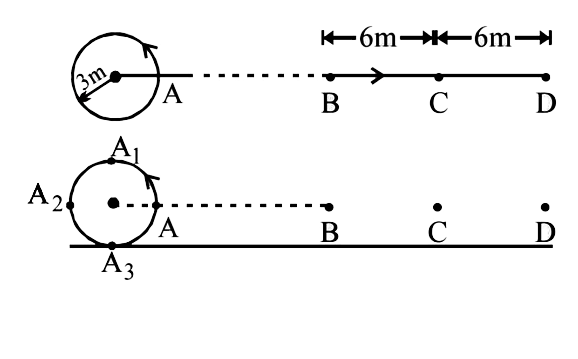A car has two horns having a difference in frequency of 180 Hz. The car is approaching a stationary observer with a speed of 60ms−1. Calculate the difference in frequencies of the notes as heard by the observer, If velocity of sound in air is 330ms−1.Solution in Gujrati
The correct Answer is:220Hz
Δf=f0(vv−vS)=180(300330−60)=220Hz
Topper's Solved these Questions
- WAVES AND OSCILLATIONSBOOK - ALLEN CHAPTER - WAVES AND OSCILLATIONSEXERCISE - Part-1(Exercise-04)[B]
13 Videos
- WAVES AND OSCILLATIONSBOOK - ALLEN CHAPTER - WAVES AND OSCILLATIONSEXERCISE - Part-1(Exercise-05)[A]
28 Videos
- WAVES AND OSCILLATIONSBOOK - ALLEN CHAPTER - WAVES AND OSCILLATIONSEXERCISE - Part-1(Exercise-03)
31 Videos
- SEMICONDUCTORSBOOK - ALLEN CHAPTER - SEMICONDUCTORSEXERCISE - Part-3(Exercise-4)
50 Videos
Similar Questions
A source of sound is moving along a circular orbit of radius 3meter with an angular velocity of 10rad/s. A sound detector located far away from the source is executing linear simple harmonic motion along the line BD with an amplitude BC=CD=6meters. The frequency of oscillation of the detector is 5π per second. The source is at the point A when the detector is at the point B. If the source emits a continuous sound wave of frequency 340Hz, Find the maximum and the minimum frequencies recorded by the detector.

View SolutionTube A has both ends open while tube B has one closed, otherwise they are identical. The ratio of fundamental frequency of tube AandB is
View SolutionStatement-1 : Sound travels faster in moist air
Statement-2 : The density of moist air is less then density of dry air.
View SolutionAt absolute zero temperature Si acts as ……..
View SolutionA source producing sound of frequency 170 Hz is approaching a stationary observer with a velocity 17 ms^(-1) . The apparent change in the wavelength of sound heard by the observer is (speed of sound in air = 340 ms^(-1) )
View SolutionCalculate the apparent frequency of the horn of a car approaching a stationary listener with a velocity of 12ms−1. The frequency of horn is 500 Hz.The speed of sound is 332ms−1.
View SolutionA car is travelling at (V)/(10) ms^(-1) and sounds horn of frequency 990 Hz. The apparent frequency heard by a police chasing the car at (V)/(9) ms^(-1) where V is velocity of sound
View SolutionA car with a horn of frequency 620 Hz travels towards a large wall with a speed of 20ms−1 velocity of sound is 330ms−1 The frequency of echo of sound of horn as heard by the driver is
View SolutionA source of sound emitting sound with frequency 540Hz approaches a staionary observer with a speed of 30 ms^-1 . If velocity of sound is taken as 330 ms^-1 , the frequency as heard by the observer will be
View SolutionA source producing sound of frequency 170 Hz is approaching a stationary observer with a velocity 17ms−1. The apparnet change in the wavelength of sound heard by the observer is (speed of sound in air =340ms−1)
View SolutionA source producing sound of frequency 170 Hz is approaching a stationary observer with a velocity 17ms−1. The apparnet change in the wavelength of sound heard by the observer is (speed of sound in air =340ms−1)
View SolutionTwo cars A and B approach a stationary observer from opposite sides with the speed of 15m/s and 30 m/s respectively.The observer hears no beats. If the frequency of the horn of the car B is 504 Hz , the frequency of the horn of the car A will be :
View SolutionA sound source emitting sound of frequency 450 Hz is approaching a stationary observer with velocity 30 ms^(-1) and another identical source is going away from the observer with the same velocity. If the velocity of sound is 330 ms^(-1) , then the difference of frequencies heard by observer is
View SolutionA police car moving at 30 m s−1, chases a motorcyclist. The policeman sounds his horn at 180 Hz, while both of them move towards a stationary siren of frequency 160 HZ. He does not observe any beats then, calculate the speed (in m s−1) of the motorcyclist round off two decimal places? [speed of sound =330ms−1]
View SolutionA Car is travelling at v10ms−1 and sounds horn of frequency 990 Hz. The apparent frequency heard by a police chasing the car at v9ms−1, where V is velocity of sound
View Solutionएक ध्वनि 30ms−1 की चाल से प्रेक्षक की और गतिमान है तथा प्रेक्षक 60ms−1 की चाल से स्त्रोत की और गतिमान है। तब वायु में ध्वनि की आवृत्ति में मित्रात्मक परिवर्तन है (ध्वनि का वायु में वेग 330ms−1)
View Solution
